Deer are an iconic animal around the world, beloved by many. From the snowy forest in Scandinavia to the sunny plains of North America, deer can be found living among a variety of landscapes across the globe. They’re divided into two subfamily groups: Old World and New World species. The United States alone is home to three common species – white-tailed deer, mule deer and Columbian black-tailed deer.
These majestic creatures are perhaps most easily recognizable for their long antlers made up of multiple points and their resident colours ranging from reddish-brown, brown and grey coats. When threatened by predators or hunters, they navigate freely through their surroundings with a running and bouncing technique known as “stotting”.
Wild deer live a precarious life – they have to face the dangers of hunting, car accidents, and even disease. These threats can quickly bring their lives to a premature end. However, in captivity, these graceful animals can reach up to 20 years of age.
Deer are herbivores that thrive on eating all sorts of vegetation sources, such as grasses, herbs and fruits. They range anywhere between 1.75 and 3.5 feet in shoulder height and weights vary from 100 to 350 pounds depending on gender; males typically being larger than females.
Continue reading to discover more about the following animals like deer:
Blackbuck
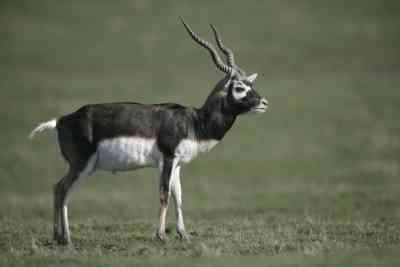
Scientific name: Antilope cervicapra
Quick summary: The blackbuck is an antelope that shares many characteristics with deer, including its general appearance and diet.
The blackbuck, or Indian antelope, has a slender and muscular body like a deer. However, it differs from deer by having spiralled horns instead of antlers–a trait that earned it its own classification as a bovid along with goats and sheep. Despite the difference in horn structure, these herbivores share similar behaviours with deer like grazing on dry woodlands and grassy plains.
They will even traverse long distances searching for water to keep themselves hydrated. Native to the Indian subcontinent, blackbucks have since spread to residences of Nepal and Pakistan as well though sadly they are labelled as endangered species. Fortunately, their lifespan is relatively high 16 years in wild areas and their population figures steadily rise.
Chinkara

Scientific name: Gazella bennettii
Quick summary: This animal has a body posture and colouring that resembles a smaller deer.
The Chinkara, also known as the Indian gazelle, is an antelope found in Iran, Afghanistan, India and Pakistan with a relatively short life expectancy of about 12 years. It stands at only 2 feet tall at shoulder height and weighs up to 50 pounds, but its body stance resembles that of more common deer found in the United States.
Both males and females have the distinct feature of lyrate horns- those curved shapes like a lyre- with the female ones being slightly smaller. Their reddish-buff bodies have white undersides and black tails, along with long slender legs and a white coat grown in winter months.
They can jump over 20 feet in a single leap when threatened or alarmed. Chinkaras show signs of caution by stamping their feet before they run away or hissing through their noses if they feel threatened to deter intruders.
Gazelles
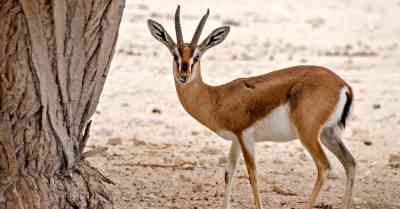
Scientific name: Gazella
Quick summary: Due to their habitat-adapted diets of grass, plant shoots, and shrubbery, gazelles resemble deer in both their slender and graceful frames as well as their herbivorous nature.
Gazelles belong to the Bovidae family, which includes antelopes, cattle, and goats. These graceful animals come in 19 species and various sizes. They are relatively small with shoulder heights ranging from 2 feet to 5.5 feet and weights of 80 to 160 pounds.
Because of their lithe bodies, gazelles can reach up to 60 miles per hour – making them both graceful and fast runners! Found in Africa, Europe, and Asia; the average lifespan of a gazelle can live 12-15 years.
Recognizable by their tan-coloured coats, white underbellies, a dark side stripe, and facial markings; gazelles also boast paired horns that extend upward in a single line but do not shed like other animals.
Roan Antelope
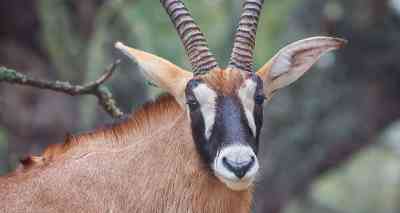
Scientific name: Hippotragus equinus
Quick summary: The roan antelope is a Bovidae with a body shape resembling both a horse and a deer and pointed, tufted ears.
The roan antelope is the true deer of Africa, with a coat just as reddish-brown and white-spotted as its European cousin, but where it differs is in the impressive 4 feet long spiralling horns it sports!
Bigger than your average deer, roan antelopes can grow up to 4.6 tall at their shoulders and weigh 590 pounds. They roam the savannas of west and central Africa, eating mostly taller grasses, leaves and succulents for up to 17 years in a herd.
Though open or sparsely wooded grasslands are their preference, these majestic animals also tend to stay close to water sources as well.
Giant Sable

Scientific name: Hippotragus niger
Quick summary: The giant sable consumes grasses and leaves like deer and has a reddish-brown coat with white markings on its legs, neck, and face.
The giant sable is an antelope native to the upper Cuanza basin in central Angola, Africa. It may at first glance be mistaken for a deer due to its strong body resembling its cousin but can be identified by judging the size, shape of horns and colouration.
It stands up to 4.7 feet tall at shoulder height and can weigh up to 600 pounds. The horns are scimitar-shaped and have been measured as long as 5 feet, arching backwards from its head.
These animals can live up to 19 years in the wild and 22 years in captivity because they thrive in forested areas near sources of water–their natural habitat in this African country
Gemsbok
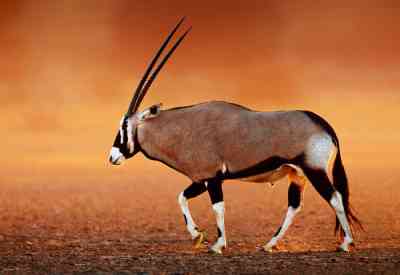
Scientific name: Oryx gazella
Quick summary: Although they are members of the Bovidae family, gemsbok is similar to deer in appearance and herbivorous diet.
Gemsboks are awe-inspiring antelopes that inhabit the wild and unforgiving terrain of the African continent. With their distinctive markings among a greyish-brown mane and illustrious horns, these robust creatures are not only well adapted to survive but thrive in their environment.
In the arid shrublands, grasslands, and deserts of Africa, they feed on bushes, grasses, and other vegetation while maintaining a lifespan of up to 20 years – much like deer that reside in captivity.
They boast a bulky front chest along with a shoulder height of almost 4 feet and an overall weight as heavy as 660 pounds for both females and males. Plus, their horns are sharp and pointed – lasting up to 2 feet in length – as they move with strong strides more akin to horses than typical deer.
Greater Kudu
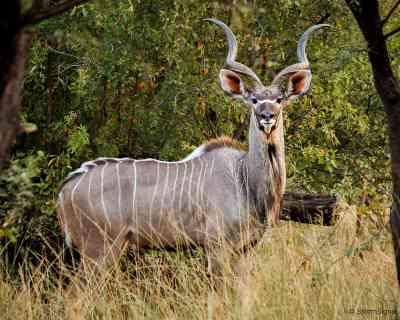
Scientific name: Tragelaphus strepsiceros
Quick summary: With their light brown coats, big round ears, and general body shape, they resemble deer.
The greater kudu is a herbivorous antelope species unlike any other, boasting some remarkable characteristics. Its most distinct feature is perhaps its vertical white stripes along its sides, designed to help it blend in with its native environment.
But the greater kudu’s size also sets it apart from other animals of this kind- these majestic creatures can grow up to 5 feet in shoulder height and can weigh an impressive 780 pounds.
They are native to many eastern and southern African regions, such as mixed woodlands and mountain scrubs, where they can often be found roaming around with their majestic spiral horns, which can reach up to 3 feet in length.
On average, the lifespan of a greater kudu is 16 years; however, these resilient animals have been known to live for much longer.
Nilgai
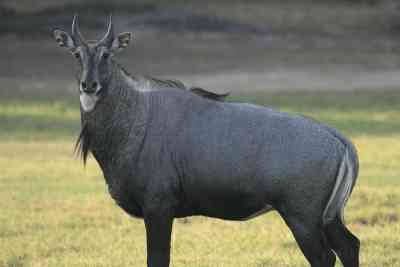
Scientific name: Boselaphus tragocamelus
Quick summary: It has an identity that resembles a cross between a deer and a horse.
The Nilgai is an interesting large mammal found in Central and Southern India. While it has a similar shape to that of a deer and horse, its coat is actually brownish-grey with white markings on its legs, underside, and face.
These animals usually weigh up to 550 pounds and grow up to 3.6 feet in shoulder height. It eats primarily a herbivorous diet of grasses, small bushes, and succulents; remarkably they can live up to 20 years in the wild despite their short lifespan when kept in captivity.
With such remarkable features, the Nilgai is a unique species within the Bovidae family that can only be found in India.
Nyala
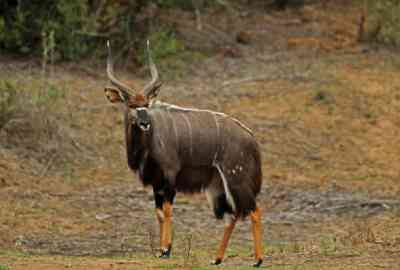
Scientific name: Tragelaphus angasii
Quick summary: The nyala is a South African antelope that looks and eats like a deer.
Nyalas are majestic animals, easily distinguished by their unique reddish-brown coat and white side stripes. Male nyalas also feature some impressive-looking long hair on the neck and chest area, as well as horns with yellow-tipped and one or two twists that can extend up to 2.75 feet.
Despite their impressive appearance, these animals are generally quite gentle and shy, living in areas of Africa such as South Africa, Zimbabwe and Mozambique. They forage for food during the evening/night hours, eating things like grass, fruits, flowers, twigs, and leaves – similar to deer – which they might eat for up to 19 years from their habitat.
Though the shoulder height of a nyala can reach up to 3.5 feet high and they can weigh up to 400 pounds making them comparable in size to larger male deer.
Tibetan Antelope
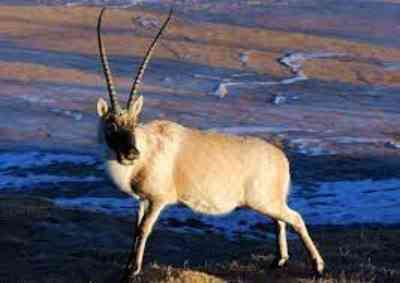
Scientific name: Pantholops hodgsonii
Quick summary: At first glance, the Tibetan antelope, known as the chiru, resembles a deer, and it also engages in foraging activities.
Standing out from other deer species, the Tibetan antelope is easily distinguished by prominent black-striped legs, a thick woolly coat, and curled horns that can grow up to two feet in length.
Enduring temperatures as cold as -40C in the alpine environment of the Tibetan Plateau, this species has adapted with its densely insulated fur. Its light frame allows it to reach speeds of up to 50mph when galloping, while its diet consisting primarily of grasses, sedges and forbs gives it sustenance within the snow.
These extraordinary mammals are typically between 2-3 feet tall and weigh relatively little between 44-77lbs. While their average lifespan is only 8 years long, they manage to successfully inhabit one of the toughest geographic areas on land due to their ability to both take cover and scavenge for food.
Tibetan Gazelle
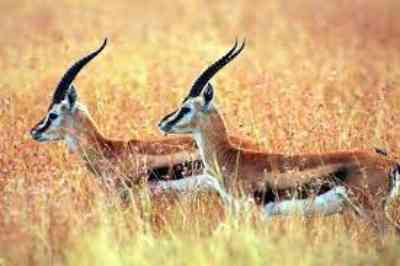
Scientific name: Procapra picticaudata
Quick summary: The Tibetan gazelle has a deer-like body and is found in mountainous and high-altitude areas of Qinghai, Tibet, and Gansu, consuming a deer-like diet.
With a body similar to that of a deer but with some distinct differences, this animal has a unique appearance. It has a light grey or brown coat with white markings on its legs, face, and underside as well as a white heart-shaped spot near the tail.
It also sports two ridged horns that slightly curve backwards and reaches around one foot in length. Its shape is compact at just two feet high at the shoulder, though it can become quite heavy with up to 51 pounds of weight.
But when it needs to run away from predators, this is not an issue – it can reach speeds of around 35 miles per hour! Its diet likewise resembles deer, being made up of seeds, shrubs, and forbs, allowing it to live up to 10 years in its habitat before moving on.
Pronghorn
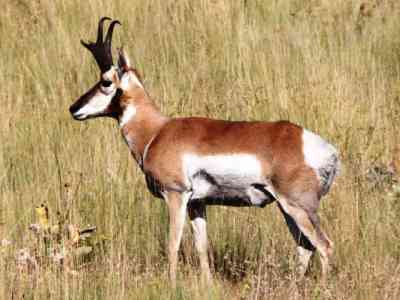
Scientific name: Antilocapra americana
Quick summary: Its body structure, ears, and curved horns are very similar to those of deer.
The pronghorn is a unique species of mammal that cannot be grouped with the deer or antelope family. Its own taxonomic classification is known as Antilocapridae, and they can only be found in North America ranging from southern Canada to northern Mexico.
Though similar in stature to most deer and antelope, the pronghorn stands up to 3 feet tall at the shoulder and weighs approximately 140 pounds.
They live for approximately 12 to 14 years in open plains, grasslands, fields, deserts, and basins and feed mainly on herbs, perennial forbs, woody plants, leaves, and cacti. A rare species indeed yet luckily still around to enjoy in its natural habitat.
Ladakh Urial
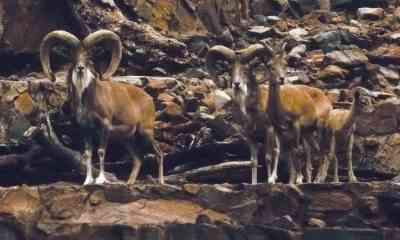
Scientific name: Ovis vignei
Quick summary: It has the body shape of a deer, with long and slender legs and light brown fur.
The Ladakh urial is an impressive creature, making it home to the rocky terrain of the Central Asian mountains. Adapted to the rocky environment, they have thick fur and hairy beards that protect them from weathering conditions.
Though these animals are often mistaken for deer due to their body shape and size, they have striking characteristics that differentiate them. The males are curled horns while the female horns are flat, giving them another distinguishing feature; though they also tend to have short tails which add to their similar appearance.
These wild sheep can weigh up to 130 pounds and stand at 3 feet tall at shoulder height, living in the Ladakh region of India for 8-12 years.
Markhor
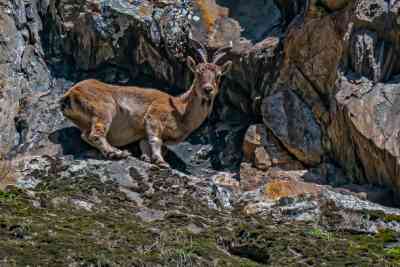
Scientific name: Capra falconeri
Quick summary: Markhors, like deer in North America, are commonly found in India’s forested habitats.
Markhors have been given many names, such as Chital, Cheetal, Spotted Deer, and Axis Deer – making them appear to be part of the deer family.
In reality, these misunderstood creatures are actually wild goats! Though their characteristics are similar to deer, with a reddish-grey coat featuring dark stripes down its back, markhors have some rather unique traits that make them stand out from the crowd.
They weigh up to 190 pounds and sport impressive horns that can reach a length of 5 feet! Additionally, their broad hooves allow for speedier movement over difficult terrain. Markhors thrive on vegetation like most deer, but they also enjoy fruits, leaves and flowers as part of their diet.
Despite an overall shorter lifespan in the wild than common deer, they can still live 10 to 12 years when provided with sufficient food and protection from predators.
Okapi
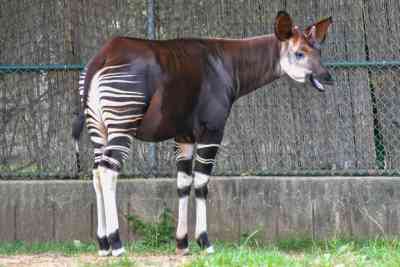
Scientific name: Okapia johnstoni
Quick summary: The okapi resembles a cross between a zebra and a deer due to its stripes and body shape.
Okapis are a mysterious species, their body shapes more closely resemble deer than giraffes, although they are part of the Giraffidae family. These rare creatures can weigh up to 550 pounds and typically measure shoulder height at 5 feet.
Only found in the Ituri Rainforest of the Central African region, okapis tend to live near river beds and can survive up to thirty years with very little hassle.
An omnivore diet including grasses, leaves and fruits as well as minerals from red clay should give them all the nutrition that they need.
Despite living such secluded lives in a very dense habitat and so rarely seen by us humans, these forest giraffes survive quite comfortably.
Vietnamese Mouse Deer
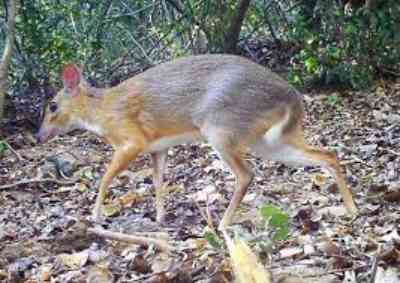
Scientific name: Tragulus versicolor
Quick summary: With its reddish-brown, silver-backed, white-spotted coat, it resembles a miniature or young deer.
The Vietnamese mouse deer (chevrotain) is an amazing species with the appearance of a baby deer, though it is not actually related to either mice or deer. This small ungulate family (Tragulidae) mammal is usually no more than one foot tall and weighs less than 10 pounds, making it approximately rabbit-sized.
However, instead of having typical antlers like deer, they have tusk-like incisors that are used for mating and territory dominance.
In terms of diet, mouse deers eat a herbaceous meal made up of fallen fruits, young leaves, fungi and shoots which all can be found on the ground.
Living in the lowland coastal forests in Vietnam and being hard to track due to their shy personality makes them unique; some individuals have lived up to 14 years.
Muntjac
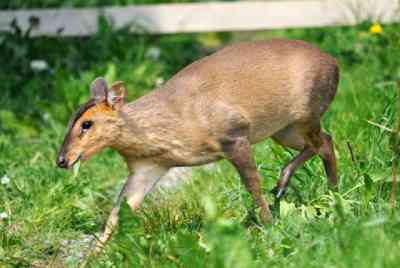
Scientific name: Muntiacus
Quick summary: Muntjacs belong to the Old World deer family and resemble deer in appearance thanks to their coat colour and resembling ear shape.
The Muntjac Deer, otherwise known as the “barking deer” because of its distinct dog-like call, is an unassuming mammal that inhabits forests of southern and southeastern Asia.
It stands taller than a medium-sized dog at about 1.7 feet high and weighs up to 40 pounds. Its reddish- or ginger-brown coat features a lighter underside with a small tail and broad leaf-like ears, giving it a unique deer appearance.
Muntjac Deer are solitary animals and their habitats often consist of thick vegetation; their diet therefore primarily consists of trees, shrubs, nuts, fungi, herbs, and shoots.
These mammals rarely exceed 19 years in age for females and 16 years for males. So the next time you hear a barking sound in the forest, look out for one of these curious creatures!
Sambar
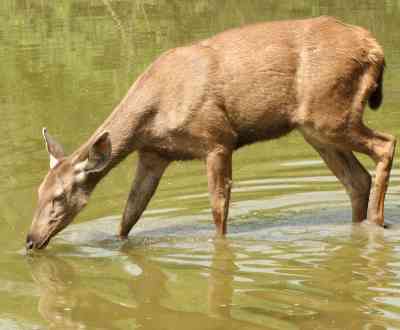
Scientific name: Rusa unicolor
Quick summary: In terms of body shape and antler formation, they resemble common deer in the United States quite a bit.
The sambar is an Old World deer species that has made its home in south Asia for centuries. Within this region, these deer are native to India and Sri Lanka, where they can be found living in a variety of environments from dry tropical forests to coniferous areas near water sources.
Unlike other species of wild deer, the sambar can reach impressive sizes at maturity, often growing up to 5.25 feet tall at the shoulder and weighing up to 1,200 pounds.
In terms of coat colours, these animals range from reddish-browns to yellow-browns and dark greys with a distinctive shaggy texture; males may also have noticeable mane hair and lighter underbellies or rumps.
While the sambar’s average lifespan in the wild is 12 years, they are known to last much longer in captivity – up to 28 years.
Barasingha
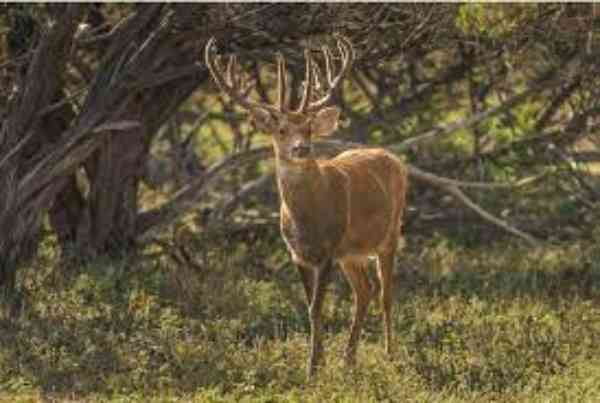
Scientific name: Rucervus duvaucelii
Quick summary: The barasingha shares many physical characteristics, such as its petal-shaped ears, with common deer.
The barasingha is an amazing species of Old World deer. With a reddish-brown coat and wide antlers that span up to 3 feet, they are truly majestic creatures. They reach a shoulder height of 3.6 feet and weigh 80 pounds.
Although they are primarily herbivores feeding on grasses and other vegetation, they have also adapted to eating aquatic plants by dipping their heads under the water.
In addition to their specialized diet, these animals also possess strong swimming and jumping capabilities which make them at home in the swampy habitats across northern and central India where they can live for up to 20 years in the wild.
Barasinghas are also found in river floodplains, tall grasslands, and mangroves.
Red Deer

Scientific name: Cervus elaphus
Quick summary: Similar to the common deer, it has branching antlers that can reach a length of 4 feet and a reddish-brown coat.
The red deer is an impressive species of Old World deer, able to reach a shoulder height of up to 4.25 feet and weigh over 400 pounds, making it one of the largest types among its relatives.
Found in parts of Europe, the Caucasus Mountains, Asia and other places around the world, their herbaceous diet includes a variety of grasses, forbs and other plant matter.
As far as lifespan goes, in captivity, they can commonly live for 20 years or more, like many common deer. What also sets them aside from other deer is that they tend to be more social creatures with an established matriarchal hierarchy.
Elk
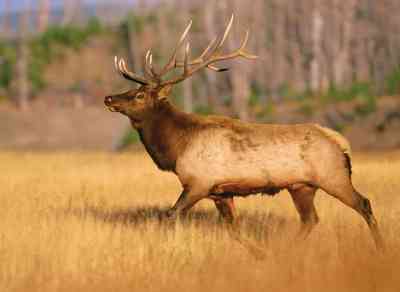
Scientific name: Cervus canadensis
Quick summary: Elks resemble common Old World deer in general appearance and have antlers with multiple points, but they are stockier.
Elk are awe-inspiring animals, not just because of their impressive size and appearance, but also because of their interesting history. The word “wapiti” that is often used to refer to them is a Native American term meaning “light-coloured deer”.
They got the nickname due to their reddish-brown fur which appears darker in the winter. They can be found in Europe and North America and typically live up to 10-13 years in the wild.
Elk tend to have quite a spacious range, with impressive heights reaching up to 7 feet from the shoulder, and weights going as high as 1,500 pounds.
Pygmy Brocket
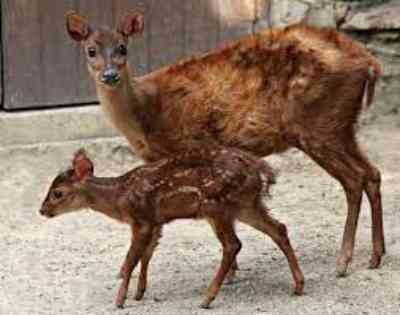
Scientific name: Mazama nana
Quick summary: The pygmy brocket resembles a young deer or a deer in the early Spring because of its short, stubby antlers and broad-leaf ears.
The Pygmy Brocket is a rare and fascinating deer, native to the Central and South American rainforests. They’re unmistakable due to their distinctive reddish-brown coat with a white underside, plus their small stubby ears and antlers give them a certain youthful charm.
Not only are these characteristics unique among deer but, due to their size, they look like the younger version of their species – with shoulder heights only reaching 2.6 feet tall.
Most Pygmy Brockets can also be expected to live between 7-16 years in the wild. A typical diet for these animals includes fruits, leaves and shoots that grow naturally in the lush environment where they call home.
Pudu
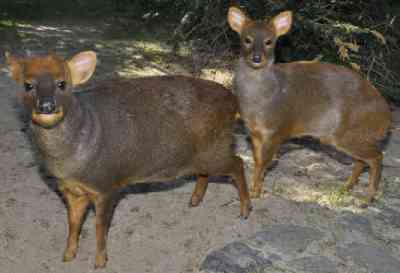
Scientific name: Pudu
Quick summary: It has a small version of a common deer’s long body, slender legs, and large ears in the shape of leaves.
The New World deer family is home to the smallest mammal in the world, the pudu. Found mainly in the temperate rainforests throughout Chile, Bolivia, Peru, Ecuador, and Argentina of South America, these animals have a lifespan of about 15 years.
While they somewhat resemble other types of deer with their body shape and fur patterning, they are far smaller measuring just 1.4 feet tall at shoulder height and weighing an average of 26 pounds – no antlers to speak of either as theirs never grow larger than 3 inches.
Pudus usually lead a solitary life that encompasses both day-time and night-time activity where they will forage for herbivorous vegetation such as vine sprouts, ferns, tree bark, fallen fruit, herbs and buds. Wetter habitats provide them with more regular access to hydration so they can survive long periods without drinking from any water sources.
Reindeer
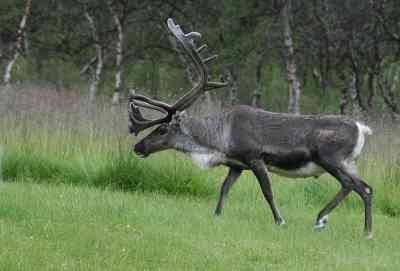
Scientific name: Rangifer tarandus
Quick summary: Similar to common deer, these creatures have long legs and antlers with multiple points, and they go by the name caribou.
Reindeer are a unique species in the deer family that have adapted to thrive in cold climates, evidenced by their white or grey coats that blend in with the arctic tundra. They are found in North America, Asia, and parts of Europe, but their ability to survive is vulnerable due to climate change.
Reindeer can weigh up to 400 pounds and still run as fast as 25 miles per hour, while they mainly feed on mosses, fungi, lichens, and other vegetation sources growing in their habitat. Interestingly enough, females also grow antlers.
Unfortunately, the increase of parasites due to climate change forces reindeer to spend more time avoiding them than feeding; this could cause a decrease in lifespan from around 15 years if no intervention is taken.
Moose
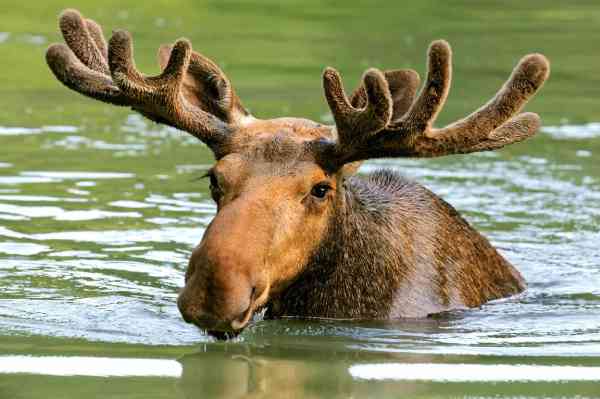
Scientific name: Alces alces
Quick summary: Moose are members of the New World deer family and can be found in North America, Asia, and Europe.
Moose are an extraordinary species of deer and among the largest land animals in North America. Reaching up to 6 feet tall at the shoulder and weighing up to 1,500 pounds, a moose towered over the usual members of its family.
Most impressive are their massive antlers that can span up to 6 feet wide and make them easily distinguishable from other deer species. The size of a moose however does not slow them down; they still have incredible agility, able to reach speeds of 25 miles per hour on land, and also possess powerful swimming capabilities.
Moose also have an impressive lifespan compared to other herbivorous mammals in their class, living between 15-24 years when in optimal health.
When it comes down to nutrition, moose live primarily off tree twigs, grasses, weeds as well as aquatic vegetation depending on their habitats which range from swamps, forests, wetlands and mountains or lowlands.
Is It Painful For Deer To Grow Antlers?
Antlers can grow to be an impressive feature on a deer without hurting them. This is because the antler growth itself isn’t painful, only potentially injurious in its initial stages when it is protected with velvety skin that’s full of nerve cells and blood vessels.
The risk of injury is increased if the sensitive skin is handled roughly or if there happens to be damage at the connection point between the skull and the antlers.
In either case, as soon as the blood flow to the velvety skin ceases and it hardens, further risks of pain are minimized as any remaining tissue will eventually rub off naturally through use.
Can You Tell The Age Of A Deer By Its Antlers?
Estimating the age of a deer can be quite a challenge due to their annual shedding of antlers. Fortunately, there are other physical characteristics that can help hunters and nature observers to distinguish ages more accurately.
- Looking at the length of legs is one way of guessing; deers under 2½ usually have disproportionately long legs compared to those that are older.
- Younger specimens often have large rumps relative to chests, while in older ones the neck blends into the chest in one line.
- Young deer possess tight and athletic stomachs while older ones have bellies that sag more noticeably.
While antler shedding may make identification tricky, these physical features can tell us much about estimating the age of a deer.
Why Do Deer Lose Their Antlers Every Year?
In the winter, the antlers are shed and regrown in the spring, as if they were a new accessory! Deer’s antlers are made of bones that branch outwards and will eventually grow up to two feet wide. Many species have numerous points sticking out from the main beam. But at the start of their growth, they can be recognized by their soft velvet skin with fine hairs wrapping around them – this provides nutrients to aid in the rapid increase in size. As these delicate structures get larger, dead velvet skin has to be removed which is why you see so many rub marks on trees.
Every year, males will shed their antlers due to the hormone testosterone. At the end of the breeding season, this causes cells to break down at the pedicle, thus weakening it and eventually resulting in antlers falling off. While females can also exhibit antlers, this is usually rare and only occurs if they have an abundance of testosterone. Despite being a natural process, this is not painful for any deer and should be understood as just another part of nature’s cycle.
Final Words
Despite the range of animals mentioned in this article, they all share similar physical characteristics making them appear as if they belong to the same taxonomic classification. Whether it is their body shape, size, colouring, or beautifully antlered horns, there is no denying the stunning similarities these species share. Undoubtedly these sleek creatures belong to the Bovidae family which encompasses cattle, goats and sheep scattered all over the world from well-forested mountains to scorching deserts. But what truly unites them is their herbivorous diets consisting mainly of foraging for local plants and grasses.
Reference:
https://awionline.org/content/deer-and-other-ungulates
https://www.fda.gov/animal-veterinary/animal-health-literacy/fun-facts-about-reindeer-and-caribou

Zahra Makda
Growing up enjoying the beauty of my village, a good passion for nature developed in me from childhood. Following my passion for the natural world, I have chosen zoology for my graduation, during my undergraduate degree, I participated in many nature trails, bird watching, rescues, training for wildlife conservation, workshop, and seminars on biodiversity. I have a keen interest in invertebrate biology, herpetology, and ornithology. Primary interests include studies on taxonomy, ecology, habitat and behavior.








